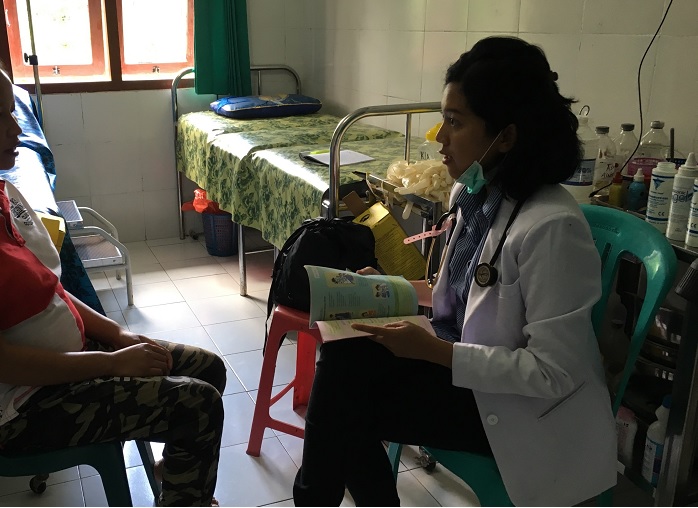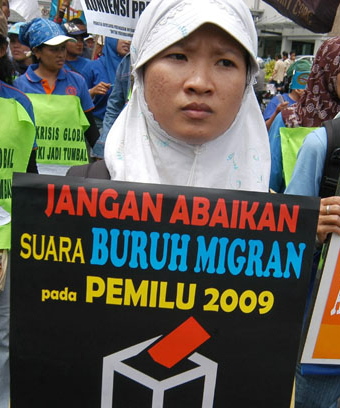Premarital sex must be acknowledged as unavoidable, to end a vicious cycle of lost potential
Aghnia Jolanda Putri & Artricia Marina Rasyid
The pregnant patient on the examination bed in front of us was barely a teenager. Her late-term belly did not seem to match her youthful face, which was anxious as she waited for her nurse at the puskesmas (community health center) in Cancar Village, Manggarai District, East Nusa Tenggara (NTT). A devout Catholic, this unmarried 15-year-old had become pregnant by her very first boyfriend, with whom she had never used contraception. Like many enu (the local term for ‘young women’) she wasn’t even aware that contraceptive products existed.
Most of the Cancar Village Puskesmas’s regular patients are Manggarai locals from low socioeconomic backgrounds – and all of them are Catholic. Ten minutes after we arrived, the head nurse informed us that she and her staff were expecting around five pregnant patients for routine prenatal check-ups in the next hour alone. The rate of adolescent pregnancy in Manggarai is sky high, and these pregnancies bring significant health and socioeconomic consequences for young people and their families.
A 2018 WHO report shows that in developing countries, approximately 21 million girls between 15 and 19 years old and two million girls under 15 years old become pregnant each year. Across Southeast Asia, six million adolescent girls have babies each year, making up approximately 16 per cent of all births worldwide. Specific pregnancy rates in the region vary drastically from country to country: in Indonesia, over two million adolescent girls (15 to 19 years old) are estimated to have given birth between 2005 and 2010, making up approximately 10 per cent of the country’s total births. It is also well known that adolescent pregnancies are closely related to unsafe abortions. Further, adolescent pregnancy acts as a barrier to achieving development goals. Ultimately, the cost of adolescent pregnancy is lost potential – for the girls, their children and their communities.
In Manggarai, two-thirds of pregnant adolescents experience health problems. From a medical perspective, this is not surprising. Moreover, in developing countries, women who experience their first pregnancy earlier in life are likely to have a higher number of pregnancies over the course of their lives. Also, the age of her first pregnancy is a known determinant of a woman’s ability to nurture healthy, well-adjusted children; adult mothers are often more capable.
According to the 2016 Manggarai District Health Office’s report on the Maternal and Child Health Program, the total fertility rate in Manggarai in 2014 was 4.87 children per woman – twice the national rate – though the actual figure could fluctuate. The district’s adolescent pregnancy rate is three times the national average. The data clearly illustrates that women in Manggarai become pregnant younger and give birth to more children with shorter intervals between each birth.
Critically, however, despite the experience they have gained through rearing more children, these young women are not necessarily more competent in rearing healthy children. The child mortality rate in NTT is alarming, at 58 per 1000 live births, and this number is on the rise, according to the 2016 NTT Health Profile report. Death-on-arrival cases of toddlers due to acute diarrhoea and pneumonia remain disproportionately high, though appropriate and timely treatment could have prevented such deaths; younger mothers are often oblivious to the symptoms and thus delay seeking healthcare services.
Enus’ unintended pregnancies and the related health risks for both mother and child form one part of the Manggarai social landscape, interwoven with various religious and sociocultural factors.
Religious considerations
Across Indonesia, sex education – and sex in general, including its depiction in movies and the media – remains taboo. While dating before marriage has become more generally acceptable, premarital sex still faces strong resistance, especially among the more religious. In NTT, Catholicism shapes the way enus understand marriage and pregnancy.
Manggarai is home to one of the largest Catholic populations in Indonesia, and virtually all young expecting mothers are unaware of the various contraception options. As such, when their boyfriends persuade them to have sexual intercourse, enus tend to not consider or suggest contraceptives, which are available over-the-counter. Moreover, unmarried youth have not been the target audience of the Indonesian government’s family planning program. As such, these youth often do not know about or have access to information on contraceptives. The church, as one of the strongest institutions in Manggarai society, encourages natural family planning and only to married couples (through the provision of moral and sexual education for their married members). Young couples who learn at church that abortion is a sin often simply decide to – or are indirectly pressured to – carry unplanned pregnancies to term.
Interestingly, some enu have already been through nikah adat (traditional, non-religious marriages), which ‘permit’ them to have sex. Many enu have nikah adat ceremonies while they are still teenagers. But according to the stipulations of the Church, young people must be at least twenty years old to receive the Catholic marriage sacrament, and without religious endorsement, nikah adat marriages cannot be registered civilly. This means that young couples married through nikah adat cannot access contraception treatments that are available for civilly married couples.
Sociocultural factors
Despite the social and religious prohibitions just described, the enus that we spoke to confided that they engage in premarital sex despite knowing that they might become pregnant. They noted their belief that family and friends would eventually accept their pregnancies.
This seeming permissiveness in Manggarai culture reflects the close social bonds among the Manggarainese, who go to great lengths to avoid breakdowns of relationships. Significantly, parents that we spoke with prefer their pregnant daughters to stay at home so that they can contribute to raising their grandchildren. Most parents echoed similar sentiments to this one: ‘[The parents] need to protect the living souls [the fetus and their daughter] and family cohesion rather than fighting about things which have already happened.’ Other local traditions also play a role in promoting this level of acceptance. For instance, one parent described how his daughter’s boyfriend – while no longer taking care of her or their child – had ‘paid off his responsibility by giving a buffalo and 25 million rupiah (A$2490)’ to their family. The family accepted the situation rather than choosing to dispute his behaviour, given that he had fulfilled the requirements of the prevailing local tradition.
In addition, consent was also an issue between enus and their partners. In many cases consent is absent, meaning that sexual activity takes place without the enu’s explicit permission. While there is not enough evidence or social and political will to categorise such sexual activity as criminal rape, the enus we spoke to said that they did not want to ‘do it’ at first but eventually went ahead after being persuaded by their boyfriends ‘for the sake of love’.
Finally, the pregnant young enu at the puskesmas felt that pregnancy was considered normal by her peers; she was not isolated by her adolescent pregnancy since she was not ‘the only one bearing a child’.

The fertility rate in Manggarai, NTT is around twice the national rate / Authors
Education and access
Adolescent pregnancy is rife with implications that extend beyond health. It often hinders a woman’s education and career development. The United Nations Population Fund argues that adolescent pregnancy is a deep violation of fundamental rights, and says it represents a failure of systems and institutions that should be protecting young people’s rights. Becoming pregnant often means that young women must give up finishing high school and, with that, the opportunities available to non-pregnant, non-child-raising young women.
One pregnant enu with whom we spoke described her desire to finish high school and go on to study Economics at university after giving birth. Another enu confided that her school cooperated with the local healthcare service to offer medical pregnancy tests for students – a deeply uncomfortable physical examination. Though not involving an invasive procedure, the tests surprised the enus, who were not expecting that their bodies would be under such physical scrutiny at a school. The enu also said that their pregnancies prevented them from hanging out with their peers as their visibly bulging bellies were a source of ridicule. Being pregnant, she said, also isolated them from one of their main social networks – religious groups – as they feared rebuke from people at church.
Organised institutions, such as education systems and the Church, appear to perpetuate this vicious cycle of isolating young women from educational opportunities.
Rethinking adolescent health
While sociocultural, religious and educational factors affect the rate of adolescent pregnancy, public health plays a central role. According to public health theory, we must consider at least three aspects of this issue – demand, supply and structural elements – in order to effectively address it.
First, on the demand side, Indonesia, as a society, should lift the taboo on conversations about sexual and/or romantic relationships among young people. Parents and adolescents should be informed – at school, at work and even at church – of the effects of risky behaviour such as engaging in sexual activity without contraception. Second, on the supply side, local governments and relevant ministries must acknowledge that adolescent pregnancy is a public health concern and a multi-sectoral problem that requires collaborative solutions. Last, on the structural side, we should anticipate that a high number of youth will engage in premarital sexual activities and evaluate the regulations hindering their access to sex education and contraceptives.
While we do not necessarily advocate that Indonesians morally accept premarital sex, we encourage them to acknowledge that it is an unavoidable part of our contemporary reality. The fact that it is unavoidable is sufficient justification for the various stakeholders to provide access to information, and formal and informal processes to allow women and adolescent girls to make the best decisions for their own lives.
On 11 October, we celebrate the International Day of the Girl Child. As public discourse and media headlines claimed – ‘the future is female’. It wouldn’t hurt, then, to ensure that girls actually have a fair shot at that future.
Aghnia Jolanda Putri (aghniajolandaputri@gmail.com) is a medical doctor and a graduate of Andalas University. She is a former general practitioner in Manggarai, East Nusa Tenggara under Ministry of Health’s internship program. During her clinical days, her work focused on adolescent health and surgery. She is now working with UNICEF and SEAMEO RECFON to develop adolescent health frameworks concerning nutrition in Indonesia.
Artricia Marina Rasyid (amr87@cam.ac.uk) recently graduated with her master’s degree in Medical Anthropology from the University of Cambridge with a scholarship from the Indonesian Ministry of Finance. She obtained her bachelor’s degree in Anthropology and Comparative Literature from New York University as an Alvin H. Zagor Scholar.














